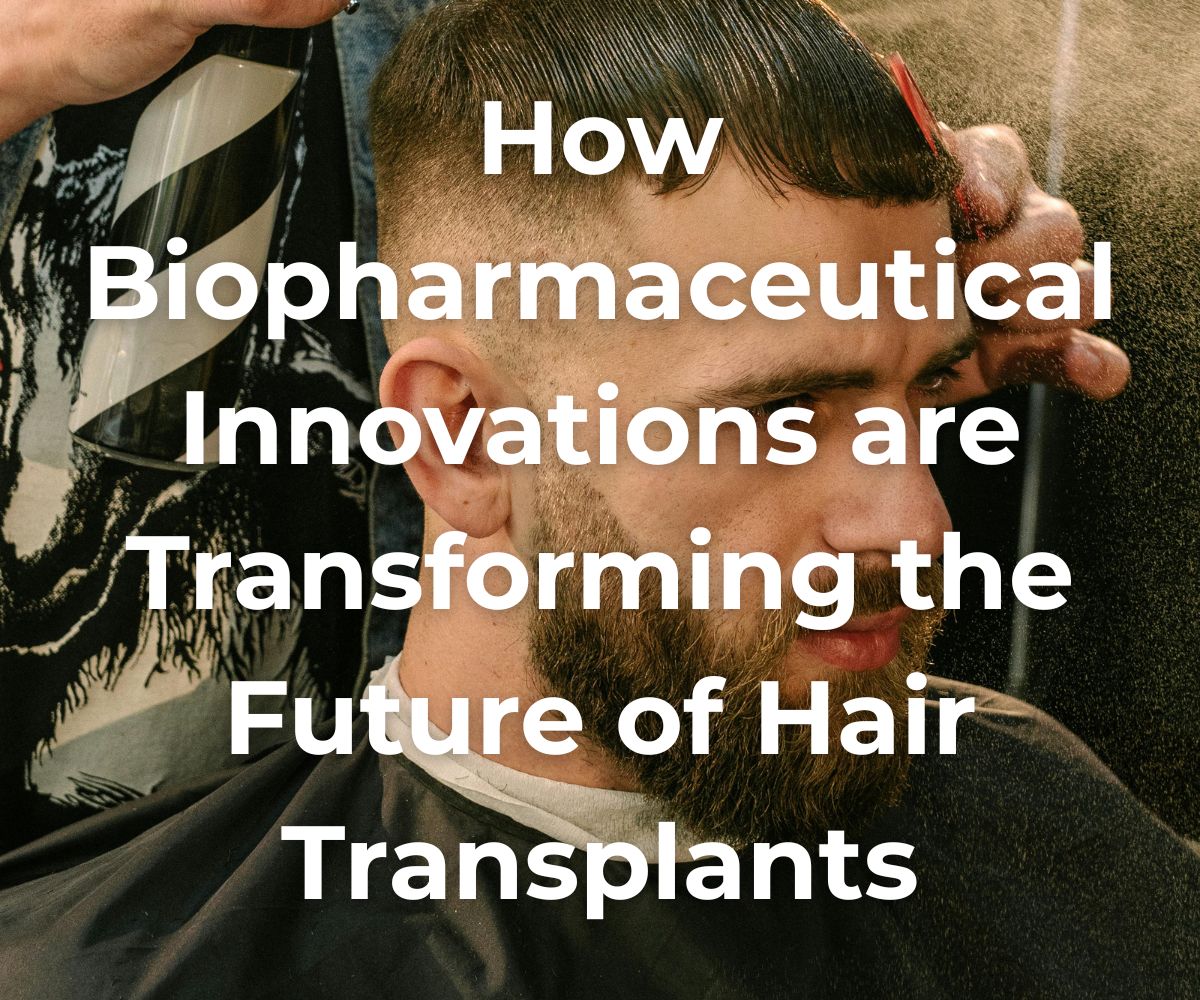how biopharmaceutical innovations are transforming the future of hair transplants
Description
Bioengineering Confidence: How Biopharmaceutical Innovations Are Transforming the Future of Hair Transplants
The world of cosmetic medicine is rapidly merging with biotechnology, and nowhere is this synergy more visible than in modern hair restoration. Today, clinics offering the Best Hair Transplant in Hyderabad are not only performing surgical procedures, they’re applying principles borrowed from regenerative biology, cellular engineering, and biopharmaceutical science.
Much like the pharmaceutical industry’s journey toward precision medicine, hair restoration has evolved from traditional grafting to personalized, biotechnology-driven therapies. This evolution is bridging the gap between cosmetic surgery and molecular science, and the parallels are profound.
Together, these domains illustrate how controlled cellular environments, growth factors, and biologic materials are changing how we heal, regrow, and restore.
The Rise of Regenerative Hair Transplantation
In early hair transplant procedures, the goal was simple: move hair from the back of the scalp to the front. The process relied on surgical skill rather than biological insight. But over the last decade, research in tissue engineering has redefined this approach.
Modern transplants no longer treat the scalp as passive skin, they treat it as living tissue capable of regeneration. The focus has shifted toward cellular activation, where stem cells, bioactive proteins, and platelet-derived growth factors stimulate dormant hair follicles.
These regenerative procedures mirror biopharmaceutical research in cell therapy. Just as scientists cultivate living cells in sterile bioreactors to create targeted treatments, trichologists are now harnessing growth factors and biological scaffolds to trigger localized tissue repair and hair regrowth. The scalp, in essence, has become a miniature bioreactor self-healing, self-regenerating, and responsive to biological cues.
Stem Cells and Bioactive Environments
One of the most exciting innovations in hair restoration is the use of autologous stem cells, cells derived from the patient’s own fat or scalp tissue to rejuvenate follicles. When these stem cells are injected into the balding area, they release paracrine factors that enhance blood circulation and stimulate the follicular microenvironment.
This technology has deep roots in biopharmaceutical research, where stem cells are cultivated for regenerative treatments targeting organs and tissues. The principle remains the same: provide a biologically active environment that encourages the body to repair itself.
In hair transplants, stem cell-enriched grafts increase the survival rate of transplanted follicles. They also improve graft anchoring, accelerate healing, and promote thicker, healthier hair growth over time. Clinics in Hyderabad have become pioneers in adapting these regenerative protocols, combining them with minimally invasive techniques like Direct Hair Implantation (DHI) and Advanced FUE (Follicular Unit Extraction) to ensure both aesthetic precision and cellular vitality.
Exosomes: The Molecular Messengers of Regrowth
While stem cells have dominated regenerative medicine for years, tiny extracellular vesicles are emerging as the next frontier. In biopharmaceutical manufacturing, exosomes are studied for their ability to transfer proteins, RNA, and signaling molecules between cells. In hair restoration, they perform a similar role: communicating “growth instructions” to dormant follicles.
When applied to the scalp after a transplant, exosomes act as molecular couriers, enhancing tissue repair, reducing inflammation, and prolonging the anagen (growth) phase of hair. They create a molecular dialogue between transplanted follicles and surrounding cells, ensuring seamless integration and sustained regrowth.
The science behind exosomes exemplifies how biopharmaceutical principles, standardized cell culture, controlled molecular release, and targeted therapeutic delivery are being repurposed to make cosmetic procedures biologically smarter.
3D Bioprinting and the Future of Follicle Replication
The dream of regenerating hair follicles from scratch is inching closer to reality, thanks to breakthroughs in 3D bioprinting. Using techniques adapted from pharmaceutical tissue printing, researchers are experimenting with printing microfollicle units composed of dermal papilla cells and keratinocytes.
In this approach, the scalp’s follicular architecture is digitally mapped and replicated using a biologically compatible “bio-ink.” Once transplanted, these bioengineered follicles integrate with the scalp’s vascular network and begin natural hair production.
While still in experimental stages, the implications are transformative. In the future, patients may not need donor hair at all; instead, a few cells from their scalp could be cultured and replicated in a bioreactor, eliminating the limitations of donor area availability. This concept borrows directly from the biopharmaceutical model, where complex biologics like vaccines and therapeutic proteins are produced using living cells.
AI and Predictive Modeling in Hair Restoration
Artificial intelligence is revolutionizing biopharmaceutical manufacturing by predicting molecular behavior and optimizing production variables. Similarly, in hair transplantation, AI is enhancing preoperative planning and real-time surgical precision.
Machine learning algorithms analyze scalp density, follicular survival probabilities, and blood flow mapping to determine optimal graft distribution. Some systems even predict the final outcome using predictive modeling, allowing surgeons to simulate results before the first incision.
This data-driven personalization mirrors precision medicine, where treatment is customized to the individual’s genetic and biological profile. The AI-guided transplant process ensures not only higher success rates but also a more natural, personalized outcome that respects each patient’s biological uniqueness.
Bioinformatics and Genetic Mapping of Hair Loss
Hair loss is as much a genetic issue as it is hormonal or environmental. The same bioinformatics tools used in gene therapy and drug discovery are now being applied to decode the genetic markers responsible for androgenetic alopecia.
By analyzing DNA sequences, scientists can identify gene clusters that regulate follicle sensitivity to dihydrotestosterone (DHT), the hormone responsible for pattern baldness. This information allows specialists to design targeted treatments that block DHT pathways or modify gene expression.
In advanced clinics, this approach is complemented by genetic counseling and personalized transplant strategies. Such integration of genomics and trichology highlights how deeply the field has intertwined with pharmaceutical biotechnology.
Sustainable Biotech in Cosmetic Medicine
Both the biopharmaceutical and hair restoration industries are embracing sustainability, reducing waste, improving energy efficiency, and prioritizing ethical sourcing of biological materials. In India, hair transplant centers are shifting toward biocompatible reagents, eco-conscious sterilization techniques, and digital patient monitoring to minimize clinical footprint.
This reflects a broader trend across healthcare where innovation is not only about efficacy but also about environmental responsibility. The same commitment to clean biotechnology that drives ethical drug manufacturing now defines the next generation of regenerative cosmetic care.
Conclusion
The modern hair transplant is not a standalone surgical procedure, it’s the culmination of decades of progress in biotechnology, regenerative medicine, and biopharmaceutical engineering. Techniques once confined to laboratories are now being applied to restore something deeply human: identity and confidence.
From stem cell-enriched grafts to exosome-driven healing and AI-guided follicle placement, the science of hair restoration mirrors the rigor and innovation seen in pharmaceutical development. Both fields aim to perfect biological control to turn the body’s own mechanisms into allies for repair, regeneration, and renewal.
As Hyderabad and other Indian cities continue to pioneer bio-integrated aesthetics, patients can now experience treatments that are not only precise and natural-looking but biologically intelligent.
To understand how similar challenges of scalability, purity, and innovation are being tackled in the pharmaceutical sector, explore this comprehensive resource on critical challenges and solutions in biopharmaceutical manufacturing. Because the science that heals diseases today is the same science that restores confidence tomorrow, one cell, one follicle, one breakthrough at a time.






















